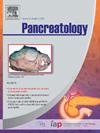The efficacy and safety profile of third-line treatment in patients with metastatic pancreatic adenocarcinoma
IF 2.8
2区 医学
Q2 GASTROENTEROLOGY & HEPATOLOGY
引用次数: 0
Abstract
Background
For metastatic pancreatic ductal adenocarcinoma (mPDAC), there are no established third-line chemotherapy options. We examined the efficacy and safety of third-line chemotherapy in patients with mPDAC in real-world practice.
Methods
We retrospectively analyzed 257 patients with mPDAC and progressive disease after first-line treatment with gemcitabine-based regimens and second-line treatment with liposomal irinotecan plus 5-fluorouracil and leucovorin at five Taiwanese medical centers from 2018 to 2022. Treatment efficacy and toxicity were analyzed in 77 of 257 patients receiving third-line treatment subsequently. We performed univariate and multivariate analyses to identify prognostic factors for overall survival (OS) in patients receiving third-line treatment.
Results
Patients receiving third-line treatment had a median OS of 4.5 months (95 % confidence interval [CI], 3.6–5.4), compared to 1.6 months (95 % CI, 1.3–1.9) for those who did not. Independent poor prognostic factors for OS included the absence of previous pancreatectomy (adjusted hazard ratio [aHR] 3.03, 95 % CI, 1.30–7.14, P = 0.001), an ECOG score of ≥2 ((aHR 9.81, 95 % CI 4.34–22.1, P < 0.001), and progressive disease response during second-line treatment (aHR 1.90, 95 % CI 1.21–8.91, P = 0.020, P = 0.020). Median OS for patients with none, one, two, and three poor prognostic factors were 15.9 (95 % CI, 12.3–19.6), 7.0 (2.6–13.3), 4.4 (3.5–5.2), and 2.0 (1.7–2.2) months, respectively. 43 of 77 patients (56 %) experienced at least one grade 3 or 4 toxicity.
Conclusion
In real-world settings, patients with mPDAC receiving third-line chemotherapy may have a moderate survival advantage, although clinicians should carefully select patients owing to high incidence of grade 3/4 toxicities.
求助全文
约1分钟内获得全文
求助全文
来源期刊

Pancreatology
医学-胃肠肝病学
CiteScore
7.20
自引率
5.60%
发文量
194
审稿时长
44 days
期刊介绍:
Pancreatology is the official journal of the International Association of Pancreatology (IAP), the European Pancreatic Club (EPC) and several national societies and study groups around the world. Dedicated to the understanding and treatment of exocrine as well as endocrine pancreatic disease, this multidisciplinary periodical publishes original basic, translational and clinical pancreatic research from a range of fields including gastroenterology, oncology, surgery, pharmacology, cellular and molecular biology as well as endocrinology, immunology and epidemiology. Readers can expect to gain new insights into pancreatic physiology and into the pathogenesis, diagnosis, therapeutic approaches and prognosis of pancreatic diseases. The journal features original articles, case reports, consensus guidelines and topical, cutting edge reviews, thus representing a source of valuable, novel information for clinical and basic researchers alike.
 求助内容:
求助内容: 应助结果提醒方式:
应助结果提醒方式:


